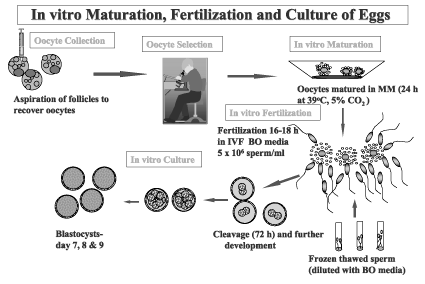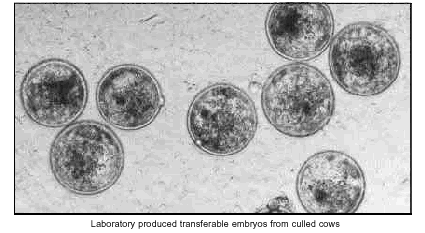An inexpensive laboratory technique has been developed at the UBC Dairy Education & Research Centre to produce embryos from eggs obtained from culled cows headed to slaughter. On a typical dairy farm, it is estimated that up to 30% of cows are culled every year and sent to the slaughter house. Although their milk production days are over, culled cows are still potential embryo donors. This is especially significant with cows of superior genetics.
In order to extend the genetics of superior dairy cows beyond the 5 or 6 calves a typical cow will produce in her lifetime, a number of reproduction technologies have been developed to increase the number of calves. The in-vivo embryo production technique has become practically feasible at the farm level. It involves hormone treatment to increase the number of eggs released and artificial insemination, followed by embryo removal and transfer to host recipients. But this technique is expensive and the number of embryos obtained is quite variable.
In the past decade, work in our lab at UBC and elsewhere has perfected an inexpensive technique to produce embryos in the laboratory from eggs obtained from slaughterhouse ovaries. The procedure involves maturation, fertilization and embryo culture in the laboratory. (Figure 1)

The present study was designed to investigate the feasibility of producing transferable embryos in the laboratory from ovaries removed from culled cows, before they are sent for slaughter. We also tested the hypothesis that removing ovaries from culled cows 2 days after standing estrus would result in a greater number of eggs being recovered and that treatment with FSH would increase this yield resulting in a greater number of embryos being produced.An important factor is to determine the optimal time for ovary removal to maximize the number of eggs aspirated for embryo production from culled cows. Eggs grow and develop in fluid-filled structures on the ovary called follicles. During each estrous cycle (21 days), a certain number of follicles are stimulated to grow by follicle stimulating hormone (FSH), which is produced by the pituitary gland in the brain. Normally one of these follicles is selected for ovulation and the rest will regress. By using ultrasound to follow the growth of follicles, we have shown that a higher number of follicles are present in the ovaries approximately 2 days after standing estrus. We have also shown that treatment with additional FSH at estrus can increase the number of follicles in the ovaries.
Twenty-one cows earmarked for culling by the UBC Dairy Education & Research Centre were randomly assigned to three treatment groups. In Treatment !, seven cows were treated with prostaglandin to induce estrus, and ovaries were removed 2 days after standing estrus. Seven cows in Treatment 2 were treated with prostaglandin and given FSH at standing estrus. The ovaries were removed 2 days later. The seven cows in Treatment 3 were not treated and the ovaries were removed irrespective of the day of the cycle. In all cases, ovaries were surgically removed through the cow’s vagina. Within 4 hours of collection, the ovaries were brought to the embryo biotechnology lab at UBC in a thermos flask containing sterile physiological saline at 30-35 degrees Celsius. The eggs were removed from the follicles, graded by quality, and only good quality eggs were used for maturation. After maturing for 24 hours, eggs were transferred to semen droplets for fertilization. Successful fertilization was recorded at 72 hours, and embryo production rates recorded on the 8th day of culture.
Based on this study, using our laboratory technique 6 to 8 transferable embryos can be economically obtained from ovaries removed from culled cows, irrespective of the stage of the cycle. The benefit to the dairy industry is the extending of genetic value to future generations.

* Dr. R. Rajamahendran, Professor in charge of the Animal Reproduction and Reproductive Technologies Program.
* G. Giritharan, Masters of Science student – thesis research project.
